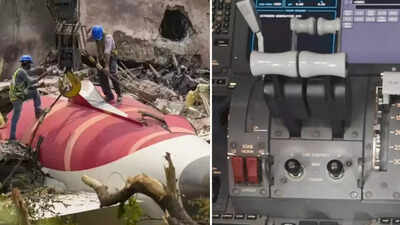Air India plane crash: The preliminary report on the Air India Flight AI171 crash has found that both engines of the Boeing 787-8 Dreamliner lost power just three seconds after takeoff from Ahmedabad due to a brief but sudden cutoff in fuel supply. The unexpected engine shutdown led to the accident that killed 260 people, including 229 passengers, 12 crew members, and 19 people on the ground. Only one passenger survived.Investigators found that the aircraft’s engine fuel control switches were briefly turned off, triggering a sudden loss of thrust and causing the plane to crash into a nearby building moments after takeoff. The Aircraft Accident Investigation Bureau (AAIB) released the findings on Saturday, along with a detailed timeline and images of the wreckage.Investigators also noted that a 2018 FAA safety bulletin had warned about possible issues with the locking mechanism of the fuel control switches on similar aircraft.
What are fuel control switches linked to Air India flight AI171 crash?
Fuel control switches regulate the flow of fuel into an aircraft’s engines. They are essential during engine start-up and shutdown procedures, both on the ground and in flight. In the event of an engine failure, pilots can use these switches to manually restart or shut down engines.Experts say these switches are designed to prevent accidental activation. However, if moved, the impact is immediate, cutting off engine power.According to US aviation safety expert John Cox, the switches and the fuel valves they control operate via independent power systems and wiring, making redundancy and reliability crucial.
Where are they located on a Boeing 787?
In the Boeing 787-8 Dreamliner, such as the one operated by Air India on Flight AI171, the two fuel switches are positioned just below the thrust levers. The aircraft involved in the crash was equipped with two General Electric (GE) engines.These switches are spring-loaded to stay in their designated position. To shift them from “RUN” (normal fuel flow) to “CUTOFF” (fuel shutoff), a pilot must first pull the switch up before moving it—ensuring deliberate action is required.
What they do and why they matter?
- RUN: Allows fuel to flow into the engine, enabling normal operation.
- CUTOFF: Stops fuel supply, effectively shutting down the engine.
The system is designed to be fail-safe, and any manual change requires purposeful input from the crew. Aviation safety experts note that turning these off during takeoff would be highly unusual and could lead to catastrophic consequences, exactly what appears to have occurred in the case of AI171.The preliminary crash report suggests both engines were starved of fuel shortly after takeoff, following a transition of the switches from RUN to CUTOFF. Investigators are now looking into how and why these switches were moved, whether due to mechanical fault, inadvertent human input, or other system malfunction. The aircraft’s fuel switches are protected by brackets to prevent unintended activation.“Thrust lever is like a car accelerator pedal, the more you open it the more power you get , the less you open it the less power you get. There are two extreme positions– one is idle power and one is full power. Then there is a fuel control switch which has got two positions– cut off and run. So when you shut down the engine or the engine is not running the fuel control switch is in cut off mode and fuel is being fed into the engine,” a veteran pilot told PTI.The engine start-up involves a two-phase procedure: activating the start selector followed by switching the fuel control to run mode, as described by the experienced pilot.“Then automatically a lot of things happen inside. The engine starts running means fuel is being fed into the engine. And the thrust lever is at idle and the engine starts running at idle. Now this movement of the fuel control from cut off to run has an electronic gate because of which you have to deliberately pull the switch out and put it to run or pull it out and put it to cut off. That’s a safety feature,” he added.The pilot further enquired, “Why is the gear lever still down? What may have happened is at the point of wanting to do gear up…both engines either deliberately or inadvertently the switches were put off. So everyone forgot about the gear.”
What did the preliminary data reveal?
According to flight data, within seconds of the aircraft reaching its peak speed of 180 knots during takeoff, both engine fuel switches moved from ‘RUN’ to ‘CUTOFF’ — one after the other, with a one-second gap. This caused an immediate loss of thrust. A cockpit voice recording captured one pilot asking the other, “Why did you shut off the fuel?” to which “the other pilot responded that he did not do so,” the report said.The switches were flipped back to ‘RUN’ 14 seconds later, triggering the aircraft’s automatic engine relight sequence. “The aircraft achieved maximum recorded airspeed of 180 knots… and immediately thereafter, the engine 1 and engine 2 fuel cutoff switches transitioned from RUN to CUTOFF position one after another with a time gap of one second,” the report added. But by then, both engines had already lost critical thrust, and the aircraft had entered a rapid descent. Despite the crew’s distress call—”MAYDAY, MAYDAY, MAYDAY”—the plane crashed into a nearby building just 32 seconds after takeoff.
The report also highlighted the deployment of the Ram Air Turbine (RAT)—a backup power source that activates when both engines fail, as seen in airport CCTV footage, with no evidence of bird activity in the vicinity.
What expert said on the preliminary report?
Aviation experts continue to stress that it is nearly impossible for a pilot to unintentionally shut off both fuel switches. “No sane pilot would ever turn those switches off in flight,” said US safety expert John Nance, especially not during the climb phase.The final cause of the crash remains under investigation, but the early findings have raised serious concerns about cockpit procedures, aircraft safety checks, and possible technical flaws.

